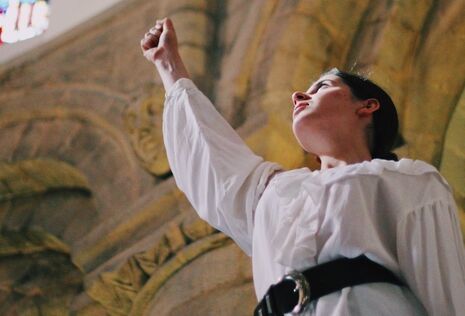Saint Joan preview
Madeleine Trépanier attends a rehearsal for Saint Joan, which promises a witty, poignant, and humanizing take on the story Joan of Arc

George Bernard Shaw’s Saint Joan is something of an unusual play. First performed in 1923, three years after the canonization of its heroine, Bernard Shaw’s play recounts the story of Jeanne d’Arc (better known in English as Joan of Arc), the peasant girl who rose to power and fame amid the tumult of the Hundred Years’ War. Claiming to hear the voices of Archangel Michael, St Catherine and St Margaret, Jeanne made her way to the court of Charles VII on what she viewed as her divine mission: to lead the French army to overthrow the English. Her success at the siege of Orléans convinced many in the French camp that she had truly been sent by God, but the English proved harder to persuade; Jeanne was captured by the enemy and burnt at the stake as a heretic. She was nineteen years old.
"At their core, these are strikingly human figures who cannot be read as either saved or sinners"
Joan’s youth is central to Bernard Shaw’s retelling. As Assistant Director Phoebe Rowell John explains, Joan is not a ‘tribal queen’, that classic caricature of the militarised woman, but is instead is ‘just a girl’. There is an earnestness and a joy to Louisa Stuart-Smith’s Joan; there is room, Bernard Shaw seems to suggest, in this story for naivete, for playfulness. Despite the place of violence in the narrative, violence which Shaw does not attempt to make light of, Saint Joan is designed to make us laugh. The text is peppered with archaisms but has a buoyant feel, while the majesty of court life seems to teeter on the verge of absurdity. I, for one, find it a refreshing watch. Director Izzie Collie-Cousins stresses that she was never really interested in trying to ‘update’ the show, in spite of the fashion for doing just that with period pieces (see Josie Rourke’s 2016 staging). This isn’t a straight period piece, she emphasises to me, and instead raises a host of more interesting questions about how we reflect on and dramatize our history. But, she does find Shaw’s characteristically humorous touch evocative in its depiction of power; authority, it seems to suggest, ecclesiastical, monarchical, or otherwise, is often ‘a bit put on’.
Assistant Director Sophie Hill is also intrigued by the question of what it means to stage Saint Joan today. As she points out, Bernard Shaw was out of fashion by the 1950s, but has recently come back into style. She largely attributes this to his skill in blending naturalism with heightened theatricality, something outmoded by the popularity of ‘kitchen sink’ dramas. By contrast, Bernard Shaw seemed lacking in psychological depth, but as Hill highlights, Saint Joan is self-avowedly a tragedy with ‘no villains’. Bernard Shaw may take pleasure in creating characters which are unashamedly theatrical beings, but at their core, these are strikingly human figures who cannot be read as either saved or sinners. Each believes themselves to be working for a moral imperative, and as Collie-Cousins puts it: ‘Guilty or innocent, it’s not a binary question.’ Needless to say, this makes for a compelling glimpse into the past, one which breathes humanity back into names and dates. In Hill’s view, staging Saint Joan is not about utilising the text to weigh in on today’s debates on politics or faith, but rather a reminder of the dangers of assuming any one side can ever have a total monopoly on morality.
This manifests on stage in the multi-rolled cast. In rehearsal, perspectives and voices shift between actors almost kaleidoscopically; watching the same tight-knit group inhabit such a variety of viewpoints, it is impossible to forget just how much these apparently different characters have in common, that however much their attitudes may diverge, they are one and the same in their common desire for justice and for spiritual clarity. But to me, the most encouraging sign in this rehearsal is the humour the cast find in every moment of the show, how ready they are to treat the text, in the words of Rowell John, ‘almost like Blackadder’ at times. They are clearly at home in Bernard Shaw’s levity, whilst also able to bring out his emotional intensity when necessary. When realised alongside the plans for medieval costume and set Collie-Cousins enthusiastically outlines, Saint Joan promises to make for a witty and poignant evening of theatre.
 News / Uni Scout and Guide Club affirms trans inclusion 12 December 2025
News / Uni Scout and Guide Club affirms trans inclusion 12 December 2025 News / Cambridge Vet School gets lifeline year to stay accredited28 November 2025
News / Cambridge Vet School gets lifeline year to stay accredited28 November 2025 News / Cambridge study finds students learn better with notes than AI13 December 2025
News / Cambridge study finds students learn better with notes than AI13 December 2025 Science / Did your ex trip on King’s Parade? The science behind the ‘ick’12 December 2025
Science / Did your ex trip on King’s Parade? The science behind the ‘ick’12 December 2025 News / Pembroke to convert listed office building into accom9 December 2025
News / Pembroke to convert listed office building into accom9 December 2025








